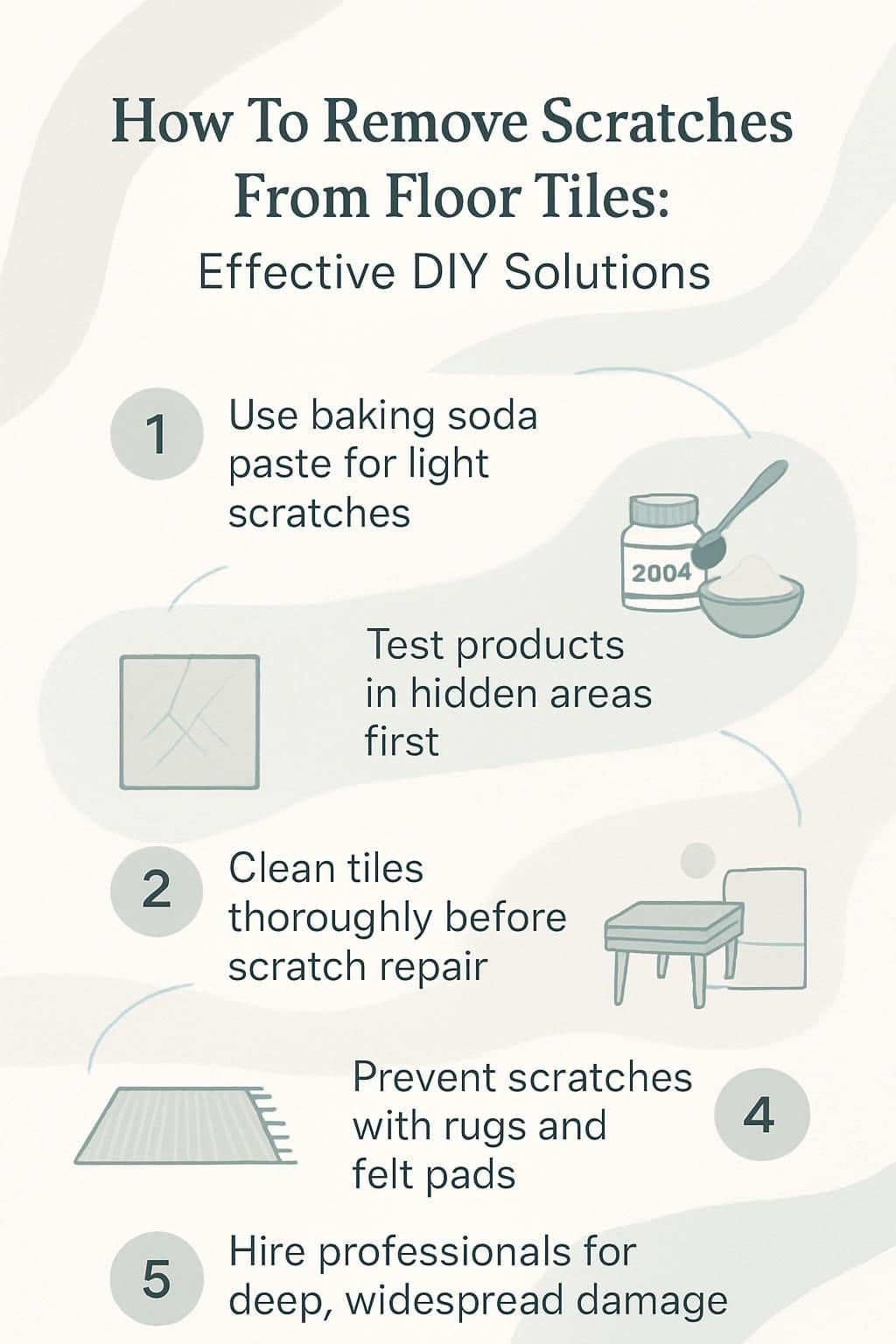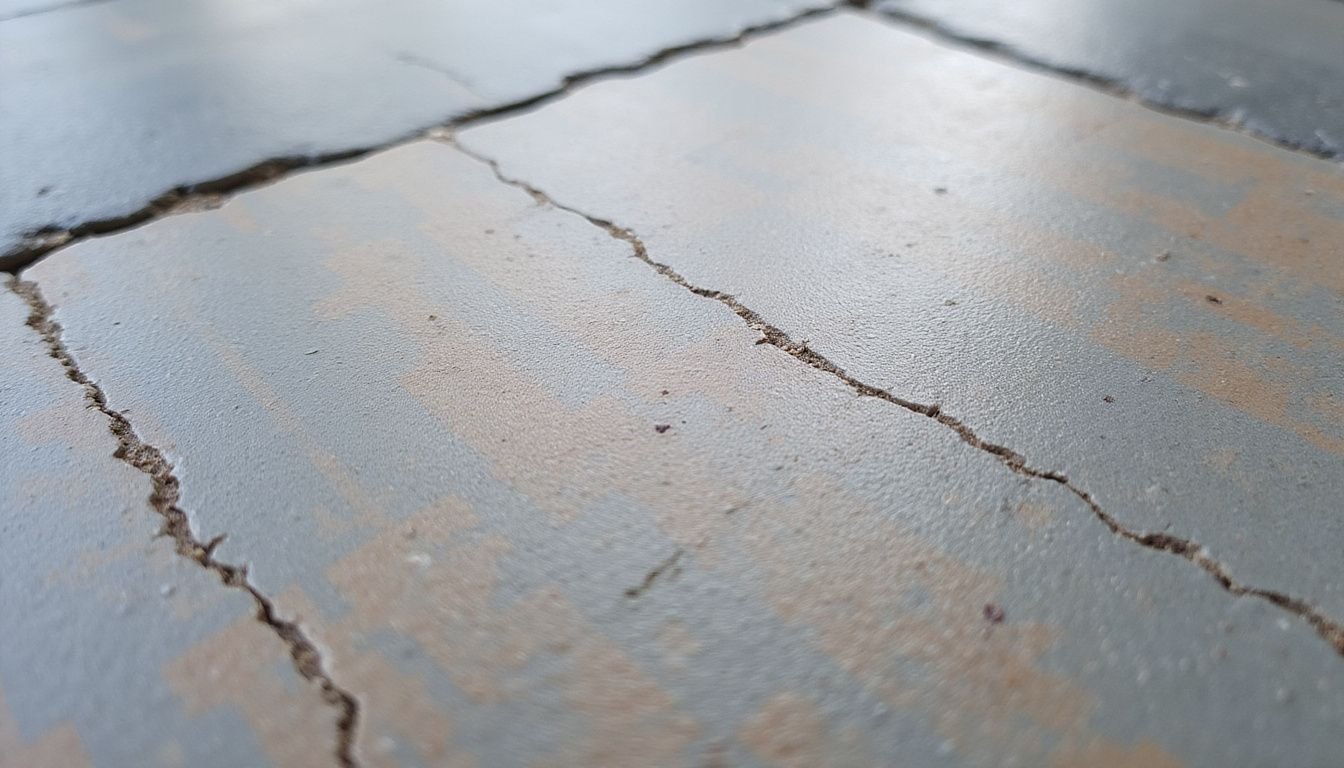Scratches on tiles can make any floor look old and worn. Many house owners and parents face this problem, especially in busy areas of the home. Searching for “How To Remove Scratches From Floor Tiles” is common when trying to keep things looking neat.
Even small marks on ceramic, porcelain, or natural stone tiles can stand out and ruin the shine.
Using simple tile cleaning solutions can remove light scratches and bring back a tile’s shine. For example, baking soda mixed with water makes a safe and easy scratch remover for most tiles.
This blog will guide readers through different scratch removal methods, including tile repair kits and DIY pastes. Find out which tools, like Magic Erasers or clear nail polish, really work.
Get simple tips for tile maintenance, scratch removal, and restoring tile durability. Learn how to fix scratches on tiles and keep your floors looking fresh. Discover the best ways to handle tile repair and see which products make buffing tiles easy.
Keep reading to find out how your floors can look new again.
Key Takeaways
- Use baking soda paste, non-gel toothpaste, or a Magic Eraser to fix light scratches on ceramic, porcelain, or stone tiles.
- For deep scratches, try tile repair kits, grout repair, vinegar and olive oil, or clear nail polish; always test first in a hidden spot.
- Always clean the tile well before fixing scratches. Test any product on a hidden area to avoid discoloration or new damage.
- Prevent new scratches by using doormats, rugs, and felt pads on furniture legs. Clean tiles often with gentle products.
- Hire a professional if scratches are deep, cover many tiles, or affect tile structure. This helps avoid bigger problems.

Identify the Type of Tile and Scratch

After learning about the basics of scratch removal, homeowners should focus on the type of surface and the scratch itself. Floor tiles come in several varieties, including ceramic tiles, porcelain tiles, and natural stone tiles.
Each tile material reacts differently to scratch removal methods and tile cleaning solutions.
Check the depth of scratches on tiles before choosing a repair method. Light surface marks may only affect the glossy coating, while deeper gouges can reach into the body of ceramic or porcelain tiles.
Natural stone tiles, like marble and granite, often show scratches more clearly due to their unique textures and finishes. Knowing whether a mark is shallow or deep guides your next step in tile restoration and buffing tiles safely without causing extra harm.
Proper tile maintenance starts with this careful inspection.
DIY Techniques for Removing Light Scratches
Homeowners often face light scratches on their floor tiles. They can use simple solutions like baking soda paste or non-gel toothpaste to help fix these marks easily. Magic erasers also work wonders in restoring the look of ceramic and porcelain tiles.
These DIY methods provide quick fixes without needing costly repairs.
Baking Soda Paste
Mix baking soda with water to create a gentle paste that works well for light scratches on ceramic tiles, porcelain tiles, and natural stone surfaces. Apply the mixture directly onto the scratch.
Use a soft cloth to rub in a circular motion. This method acts as a mild abrasive without damaging tile durability or finish.
Rinse the area with clean water after buffing tiles with baking soda paste. Dry thoroughly to prevent streaks or residue. Repeat this process if any scratches remain visible. Always clean floor tiles first and test the solution in a hidden spot before using it across larger areas, which protects your investment during tile maintenance and repair routines.
Non-Gel Toothpaste
After using baking soda paste, non-gel white toothpaste stands out as a simple option for scratch removal on floor tiles. Apply a pea-sized amount of toothpaste to a soft cloth or microfiber towel.
Rub the scratch in small circles using gentle pressure. This technique helps erase minor scratches from ceramic or porcelain tiles without harsh abrasives.
Thoroughly rinse the tile with clean water after treatment and dry it well to prevent residue buildup. Always test non-gel toothpaste on a hidden part of the tile before wider use, since some surfaces may react differently and risk discoloration.
Non-gel toothpaste offers house owners and parents an affordable fix for surface marks while supporting regular tile maintenance routines.
Magic Eraser
A Magic Eraser works wonders on light scratches found on certain types of tiles. It can lift marks effectively, making flooring look better without much effort. House owners should test it in a hidden area first to prevent discoloration.
Cleaning the scratched surface is crucial before using the eraser; this ensures optimal results.
Use the Magic Eraser gently to avoid causing more damage to the tile surface. After use, let the tile dry completely. This prevents any moisture-related issues that might arise later.
It’s one option among several for removing scratches, alongside baking soda paste and non-gel toothpaste.
DIY Techniques for Removing Deeper Scratches
For deeper scratches, homeowners can effectively use tile repair kits or vinegar and olive oil to restore their floors. Grout repair works wonders for scratches on grout lines. Clear nail polish also offers a quick fix for small imperfections.
Don’t forget to explore these options to bring your tiles back to life!
Tile Repair Kits
Tile repair kits contain essential tools and fillers that assist homeowners in fixing scratches on their floor tiles. These kits are effective with various tile types, including ceramic, porcelain, and natural stone.
Owners should follow the instructions carefully to achieve optimal results.
For deeper scratches, acquiring a tile repair kit proves advantageous. It offers specific products crafted to blend seamlessly with the existing tile surface. Testing the repair kit in a less visible area ensures compatibility before applying it widely.
Using color-matched products alongside these kits increases success in restoring tile durability and appearance.
Grout Repair for Scratches on Grout
Transitioning from tile repair kits, grout repairs can effectively address scratches on grout. Homeowners should mix color-matching grout with water to create a paste that fills in the scratched areas.
Using a sponge, they can scrub the paste into each scratch and wipe away any excess for a smooth finish.
For deeper scratches, applying color-matched paste wax will help restore appearance after buffing once it dries. Clear nail polish is also useful for small hairline scratches; just ensure to clean the area thoroughly before application.
These simple solutions offer effective ways to maintain tile durability and improve aesthetics in homes.
Vinegar and Olive Oil Solution
Mixing vinegar and olive oil creates an effective solution for minor scratches on tile surfaces. This method works well on ceramic, porcelain, or natural stone tiles. Combine equal parts of both ingredients in a spray bottle.
Spray the mixture onto the scratched area and let it sit for a few minutes.
Next, use a soft cloth to buff the scratch gently. The vinegar helps remove dirt while the olive oil adds shine back to your tiles. Regular cleaning with this solution can improve tile durability and keep them looking great over time.
Clear Nail Polish
Clear nail polish offers a simple solution for small, hairline scratches on floor tiles. Homeowners can easily apply it to these marks. The surface of the tile needs thorough cleaning before use.
After applying the polish, allow it to dry completely.
Once dry, wipe away any excess polish gently. This method works well for deeper scratches and helps restore the tile’s appearance effectively. Testing the clear nail polish on an inconspicuous area first is wise to prevent discoloration or damage.
Polishing the Tiles After Scratch Removal
After removing scratches, polishing tiles brings back their shine. Homeowners can use tile polishing compounds or common items like car wax and brass polish for a brilliant finish.
Use of Tile Polishing Compounds
Tile polishing compounds help restore shine to worn-out tiles. Homeowners can use these products after removing scratches from their floor tiles. These compounds contain fine abrasives that smooth out the surface and improve the tile’s appearance.
Applying a tile polishing compound is straightforward. First, clean the tile thoroughly to remove dirt and dust. Next, apply the compound using a soft cloth or buffing pad. Buff in circular motions for even coverage.
This process enhances aesthetics and also adds a layer of protection against future scratches, making it crucial for effective tile maintenance and restoration efforts.
Car Wax or Brass Polish for Shine
After using tile polishing compounds, homeowners can further enhance the shine of their tiles with car wax or brass polish. These products work well on deeper scratches in floor tiles.
After addressing the scratches, apply a thin layer of wax or polish to boost your tile’s luster.
Choose a color-matched paste wax for optimal results before applying any additional products. Allow the wax or polish to dry completely before buffing it out for maximum shine. Always test in an inconspicuous area first to ensure no adverse effects occur during application.
This simple step ensures effective tile maintenance and beautiful results for ceramic, porcelain, and natural stone tiles alike.
Preventing Future Scratches
To prevent future scratches, homeowners can place mats and rugs at entryways. They should also stick felt pads on furniture legs to protect tiles from scratches caused by moving furniture.
Use of Doormats and Rugs
Doormats play an essential role in protecting floor tiles. They prevent dirt and debris from being tracked inside, which reduces the risk of scratches on surfaces. Homeowners can place doormats at every entrance to keep tiles cleaner and safer.
Rugs also provide significant protection, particularly in high-traffic areas. They absorb impact, reducing wear and tear on tile flooring.
Utilizing both doormats and rugs helps maintain the condition of floor tiles. Regular use contributes to extending the life of the flooring while enhancing its appearance. Investing in quality mats and rugs is a wise choice for families aiming to protect their homes efficiently.
Felt Pads on Furniture Legs
Using felt pads on furniture legs offers an easy way to protect floor tiles. These pads reduce friction and pressure when moving furniture, helping to avoid scratches on tiles. Regularly checking these pads is essential; worn felt can become less effective over time.
Incorporating felt pads is a cost-effective preventive measure compared to repairing scratched tiles. House owners and parents often find it easier to maintain their spaces with this simple solution in place.
Regular Cleaning to Avoid Abrasive Dirt
Regular cleaning of floor tiles plays a crucial role in maintaining their appearance and durability. Dirt and debris easily accumulate on surfaces, leading to scratches over time. Sweeping or vacuuming regularly helps remove loose particles that can cause abrasiveness.
Mopping with suitable cleaners also prevents grime buildup. Including these tasks into a cleaning routine minimizes risks to tile integrity.
Homeowners should focus on using the right tools while cleaning, such as soft mops and non-abrasive solutions suitable for various tile types. This approach protects the surface from damage while ensuring effective dirt removal.
Keeping floor tiles clean enhances their look and prolongs their lifespan, making it an essential part of tile maintenance.
Important Considerations
Before applying any scratch removal solution, homeowners should test each method on a small, hidden area of the tile. Cleaning the surface thoroughly prior to treatment can help ensure better results.
By taking these precautions, individuals can avoid further damage and achieve effective restoration. Discover more ways to care for your tiles!
Testing Methods in Hidden Areas
Testing scratch removal methods in hidden areas offers a smart approach for homeowners. This step helps prevent discoloration or damage to the tiles. Each tile type responds differently, whether it’s ceramic, porcelain, or natural stone.
Using a small amount of the chosen solution on an inconspicuous spot can reveal how well it works without risking visible harm.
House owners should check multiple locations if possible. Varying angles and light conditions may show different results. If any discoloration appears after testing, immediately stop using that method to protect tile durability.
Ensure thorough cleaning before applying any solutions for effective scratch removal.
Cleaning the Tile Before Applying Solutions
Cleaning the tile plays a vital role in scratch removal. Clear dirt and debris from the scratched area first. This step prevents unwanted particles from causing more scratches during the repair process.
House owners should use a damp cloth or mop to wipe down the surface thoroughly.
After cleaning, allow the tile to dry completely before applying any solutions. This ensures better adhesion and effectiveness of products like baking soda paste or tile repair kits.
Testing methods in hidden areas helps avoid discoloration or damage to ceramic, porcelain, or natural stone tiles. Following these steps sets a solid foundation for successful scratch removal and maintenance of beautiful tiles.
When to Seek Professional Help
Deep scratches on tiles often require more than DIY methods. House owners may need professional assistance if they notice damage that is extensive. Professionals can assess the situation and provide effective tile repair solutions.
They also handle issues related to structural integrity concerns, which homeowners might overlook.
If many tiles show signs of scratching or damage, it’s wise to consult an expert for a uniform solution. Some scratch removal products could discolor tiles or cause further harm.
Seeking guidance from a professional helps avoid these potential risks and ensures proper care for ceramic, porcelain, or natural stone tiles. Tile restoration becomes seamless with skilled help at hand; this leads directly into discussing polishing techniques after any scratch removal efforts.
Conclusion
Removing scratches from floor tiles can be straightforward and effective. Homeowners have many DIY solutions at their fingertips, such as baking soda paste or non-gel toothpaste. For deeper scratches, tile repair kits and clear nail polish offer excellent results.
With proper care and maintenance, parents can keep their tiles looking new for years to come. Taking these steps ensures that families enjoy beautiful floors without the hassle of unsightly damage.
FAQs
1. What are the best ways to remove scratches from ceramic tiles at home?
Use tile cleaning solutions designed for ceramic tiles, then buff the surface gently with a soft cloth. For deeper marks, try tile polishing products or a paste of baking soda and water.
2. Can I repair scratches on porcelain tiles without calling a professional?
Yes, many minor scratches can be fixed using DIY scratch removal kits or by gently rubbing with fine steel wool. Tile restoration products also help improve porcelain tile durability after repair.
3. Are there special methods for scratch removal on natural stone tiles?
Natural stone needs careful treatment since it is softer than other materials. Use only approved tile maintenance cleaners and avoid harsh chemicals; gentle buffing often restores shine and reduces visible damage.
4. How do I keep my floor tiles looking new after repairing scratches?
Regularly clean your floor using proper tile cleaning solutions and maintain a routine of buffing tiles to keep them polished. Consistent care increases both appearance and overall tile durability.
5. What myths exist about removing scratches from floor tiles?
Some believe all scratches require full replacement of the affected area, but most can be managed through simple DIY techniques in tile repair and restoration. Using correct products often saves both time and cost while protecting your floors’ look.


